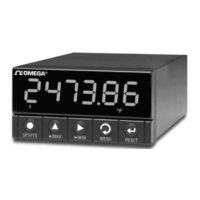7-3
7.2.2 ALARM MODE
All devices can be put into the alarm mode simultaneously by a single address 00
command. In the alarm mode, the bus is quiet until one of the devices detects and
alarm condition. It then transmits its address onto the bus and goes out of the alarm
mode. When other devices detect a character on the bus, they too go out of the alarm
mode. The host program, which may have been performing an unrelated task, is then
interrupted by receipt of a character and after a short delay, starts polling all devices.
It begins with the received address device. All devices are polled in case two or more
have reached an alarm condition at or near the same time. If this happens, it can
cause bus contention, corrupted characters or framing errors. However, none of these
result in system failure because any bus activity causes all devices to exit the alarm
mode and the host program to perform the alarm poll. After identifying the alarm
device(s), the alarm can be reset and the host controller can put the devices back into
the alarm mode. It is suggested that the host controller polls all of the devices when
ready to send the common alarm mode and sends it only if all alarms are inactive.
This reduces the probability of two or more devices being ready to transmit on the bus
simultaneously when the alarm mode is entered due to existing alarm conditions.
7. Classes of Operation

